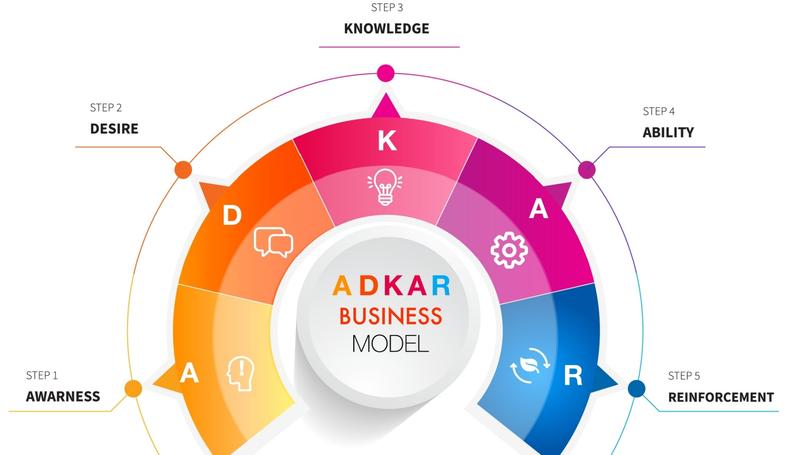ADKAR model

What is the ADKAR model?
The ADKAR model, often called the "change curve", is a structured change management framework consisting of sequential steps. It emphasises that the success of organisational changes hinges on how employees perceive and are prepared for these changes. Therefore, within the ADKAR definition, the process begins with individual, internal changes before progressing to broader, organisational changes. Today, ADKAR is a comprehensive approach widely regarded as one of the most effective change management models globally.
Engineer Jeff Hiatt developed the ADKAR model in the late 1990s. He observed that equally essential and beneficial improvements were adopted differently across businesses. After analysing over 300 companies, he discovered the critical factor was the employees and their reactions to these changes. To put it simply, even if employees adhere to clear instructions for both changes, one transformation might succeed. Simultaneously, the other fails due to internal resistance from the team or a failure to convince them of its effectiveness.
What does ADKAR represent?
Since the ADKAR model is designed to manage both business and individual changes, it can be applied to organisational transformations and personal life. For instance, using ADKAR, you can create:
-
A project roadmap detailing the changes' sequence, implementation, deadlines, costs, etc.
-
A communication plan that enhances employee interactions during changes, preventing misunderstandings and conflicts during the adaptation process.
-
A personal growth and development plan for each employee, considering the positive aspects of the changes they will encounter within the company.
-
A training plan outlining how employees need to adapt to the changes.
-
A plan to reduce employee resistance by addressing the perceptions that, as Jeff Hiatt discovered, most hinder effective business changes.
Simultaneously, the ADKAR change management model is highly adaptable to the needs of each employee. For instance, if an employee shows reluctance or moral unreadiness for change, ADKAR's primary focus shifts to addressing and working with their resistance. Suppose an employee is open to changes but needs to gain the necessary learning. In that case, ADKAR focuses on providing explanations and developing the skills required. The ADKAR phases cannot be omitted or skipped. Still, you can involve different employees based on their particular needs and expand or deepen certain steps as necessary.
In a business context, ADKAR identifies obstacles that could impede organisational change. For personal use, it focuses on barriers preventing you from achieving specific goals, like moving abroad. Therefore, ADKAR is versatile and suitable for use in any area of life.
How to utilise ADKAR

As previously mentioned, ADKAR comprises a series of stages that must be followed in a specific order. Each stage is represented by the acronym ADKAR, outlining the essential steps required to initiate, implement, and stabilise changes:
A-awareness. At this stage, it's vital to recognise the changes' importance, value, and necessity. Employees (or yourself, if using ADKAR for personal purposes) need to understand:
-
Why alter the existing current activities?
-
Why change us?
-
What will happen if we do NOT change anything?
To increase the level of understanding in the team, the following actions are taken at this stage:
-
A "change leader" is designated-someone who can effectively communicate the significance of the changes and persuade others of their value.
-
A presentation is created to illustrate the potential consequences of not implementing the changes on time. For example, the company might face profit losses or lay-offs, etc.
-
Past change initiatives are reviewed, and their shortcomings are identified and discussed with the team to determine how to avoid repeating the same mistakes this time.
-
Additionally, discussing any concerns, fears, or doubts about the changes and addressing what might be causing anxiety or hesitation is essential.
D - desire. Uncovering what motivates employees to engage in the changes is crucial at this stage. To achieve this, it's critical to address questions such as:
-
Why are these changes necessary for my work or personal growth?
-
Is my participation vital?
-
What advantages will I gain from this?
-
What will I achieve from these positive changes?
To ensure the "Desire" stage progresses smoothly, the following actions are recommended:
-
Engage senior management. Jeff Hiatt's research indicates that employees are more likely to embrace changes when they observe management's active involvement. Additionally, it is crucial for management to communicate the benefits of these changes clearly and to lead by example by being the first to adopt and initiate them.
-
Identify or designate a mentor to facilitate the changes. This could be an external innovation expert or a passionate team member in a corporate setting. For personal development, consider seeking guidance from a coach, psychologist, or a knowledgeable acquaintance willing to mentor you.
K - knowledge. Employees are trained in new approaches, procedures, or tools at this stage, putting the implemented changes into practice. This is the third stage because, without proper motivation, practical training is impossible, and there is a risk of abandoning the effort midway. Therefore, it is crucial to address the following questions:
-
What skills must you develop to implement the changes effectively?
-
Where can you acquire these skills, and how?
To achieve this, the following actions are undertaken:
-
Review the current knowledge base, update it with the latest information, and ensure all employees have free access to it.
-
Establish a corporate training program that is entirely free and highly flexible (preferably online), allowing employees to complete it at their convenience and in a format that suits them best.
-
Offer employees additional training opportunities, such as courses, expert consultations, and access to supplementary programs. It's also crucial to gather feedback and tailor the training accordingly, as employees will likely identify their knowledge gaps while adapting to changes and finding the most effective ways to address them.
A - ability. At this stage, the acquired theoretical knowledge begins to be applied in practice, transforming into actionable skills. Therefore, it is essential to address questions such as:
-
Where can I put this knowledge into practice, and how?
-
Who should I contact if I encounter difficulties or face problems? For instance, what steps should I take if I need additional training to fill knowledge gaps?
The primary goal of this stage is to assist employees in quickly putting their knowledge into practice and to close the gap between those who quickly mastered the information and those who faced challenges due to fears, age, job specifics, etc. Therefore, the following actions should be undertaken:
-
Re-offer access to even more comprehensive and up-to-date knowledge (or remind employees of its availability).
-
Assign a mentor or assistant to employees with doubts or difficulties applying their knowledge.
-
Allow employees additional time to adapt by reducing their workload or providing greater flexibility and manoeuvrability.
R - reinforcement. At this stage, changes within the company or an individual's life are solidified to prevent reverting to old habits, tools, strategies, etc. To achieve this, it is essential to address the following questions:
-
What results can we expect once we reinforce the changes and achieve our goal?
-
What reward will we receive?
-
Will continuing on this path lead to more rewards and achievements in the future?
The following actions can be applied here:
-
Develop a transparent system for measuring progress and evaluation.
-
Establish a reward system matching efforts to boost engagement and sustain interest in the changes.
-
Consistently document, acknowledge and celebrate the team's achievements and successes.
The pros and cons of the ADKAR model

The ADKAR methodology has its pros and cons. The advantages, which also serve as the core principles of ADKAR, include:
-
ADKAR offers a practical, hands-on approach to implementing changes and not a theoretical approach, focusing on altering perceptions and behaviours in the present moment. This model has been extensively tested and proven effective, primarily due to the efforts of Jeff Hiatt's company, Prosci, which was established to promote and apply the ADKAR methodology.
-
ADKAR is a ready-made solution with a fixed template. A vital feature of the ADKAR change management model is that it does not require adaptation, adjustment, or modification. It is universal, suitable for most businesses, and does not necessitate special knowledge. Additionally, the model is designed to remain unchanged, which will be discussed in more detail below.
-
Prosci has developed various specialised software frameworks and services for ADKAR. Additionally, it offers training, ADKAR certification, and support to businesses embarking on change initiatives.
-
As previously noted, ADKAR also applies to personal life, focusing on individual-level changes. Therefore, with ADKAR, you can initiate changes in personal habits, thinking, learning, and even career development.
However, the ADKAR model does come with certain drawbacks, such as:
-
ADKAR offers a practical, ready-made solution. Still, it doesn't delve deeply into any new information about the nature of the changes or the business itself, concentrating instead on employees and their adaptation.
-
This procedure is very straightforward, making it unsuitable for multi-level and complex enterprises and companies that are gathering feedback and facilitating interdepartmental interaction, which is challenging.
-
In the ADKAR model, the sequence of stages is fixed, and you cannot skip or rearrange them. For instance, starting directly with the training stage without first addressing awareness and needs may result in employees not completing the training. Additionally, suppose you halt at the training stage without reinforcing the results. In that case, there is a risk of decreased productivity and higher staff turnover, as employees may feel unsupported. Therefore, ADKAR's hierarchical structure can quickly become ineffective when changes or adjustments are needed.
Overall, the ADKAR model's strengths and weaknesses balance each other out, making it a versatile and widely applicable framework.
ADKAR model real-life examples

Let's explore how the ADKAR model can be applied in practice, step by step, using the example of Andrew, the owner of Company N, who personally manages the sales department. Andrew aims to modernise his team's tools and methods to boost the number of successfully closed deals. Within the ADKAR framework, he needs…
Stage 1. Awareness
Andrew, as a manager, understands the changes that the department needs. However, his employees are deeply accustomed to the old methods and resistant to improvements, largely because many of them are experienced sales professionals from an older age group.
What Andrew can do in this situation:
-
Organise a meeting and deliver a clear, engaging presentation to explain the planned changes and their necessity. Highlighting the anticipated improvements in performance metrics and the benefits for employees. For instance, instead of making fifty calls a day, they will only need to make ten manually, reducing their workload. Additionally, a chatbot will handle initial client interactions, ensuring that clients are well-prepared and know what they want, thereby speeding up the deal-closing process.
-
Incorporate credible information about competitors and market trends into the presentation to illustrate how the company's situation could deteriorate if these changes aren't applied promptly. It's crucial to instil a sense of responsibility in employees for the company's results and well-being, emphasising that the success of these changes hinges on their acceptance and support.
-
Present employees with a detailed ADKAR change management plan and a timeline for implementing the changes. Andrew should ensure that everyone is comfortable with the plan, fostering a sense of confidence and clarity within the team. He can also offer personal assistance to anyone who needs further explanation.
-
Appoint a 'change leader.' Andrew likely has a trusted team member to whom he frequently delegates important tasks or who has been supportive of the changes from the beginning. He can designate this person as a mentor to assist in training and motivating others.
Stage 2. Desire
While Andrew, as the manager, clearly understands the need for these changes due to the potential increase in his profits, employees may see different benefits. Normally, most employees are focused on completing their primary duties, leaving work, and going home on time. Even if the improvements are designed to make their jobs easier, they may need more motivation. Each individual has their own motivation, which generally aligns with one of the four 'poles': power, money, achievements, and security.
What Andrew can do at this stage:
-
Highlight the connection between business growth and employee salaries. For instance, if the new changes are successful, the number of clients could increase by 35%, leading to a 48% rise in company profits. As a result, employees would receive a bonus, or a permanent salary increase of at least 20% of the additional profit.
-
Establish a system of additional rewards. For instance, Andrew could offer an extra day off to employees undergoing training, allowing them to adapt to the innovations at a more relaxed pace.
-
Address employees' objections and doubts. For instance, older salespeople might claim that 'new tools cannot be more effective than old ones.' Andrew needs to recognise that this stems from a fear of not being able to adapt and cope with new technologies. To alleviate this, he can provide more supportive circumstances for learning the innovations and demonstrate the effectiveness of new approaches through practical examples and statistics.
Stage 3. Knowledge
Andrew has already communicated the importance, necessity, and benefits of the changes to his team. Now, it's crucial to implement these changes and ensure employees fully master them. Instead of merely sending guides and YouTube tutorials, Andrew needs to monitor their understanding actively. To achieve this, he can:
-
Personally conduct a training session on client communication using the new changes. Andrew can organise a role-playing exercise where some employees act as clients with unconventional questions. This will also demonstrate how effectively the new changes handle scenarios that the old one couldn't manage.
-
Provide employees with homework and useful materials. Andrew can prepare tests or a brochure in FAQ format, containing the most important questions and his comments, which employees can refer to any time they forget something.
-
Pay for online courses or hire an expert mentor. Since the first option is more cost-effective, Andrew will choose it. He will provide his team with general access to courses on a well-known platform, such as Lectera, so that they can study remotely at a time convenient for them.
Stage 4. Ability
The change management process is well underway! However, it's crucial to keep monitoring it until the new changes become routine for all employees. To achieve this, Andrew must:
-
Ensure there are no gaps in the previous stages. For instance, an employee might struggle with the practical application of a tool due to a lack of understanding during training, or they might not fully grasp their motivation and the necessity of the changes. In such cases, Andrew should revisit and repeat the missed stage for that particular employee.
-
Gather feedback. Andrew sent out an email invitation for a survey to pinpoint any gaps and assess his team's progress. He also holds periodic informal meetings to check in on everyone's progress, see how everyone is doing, and address any concerns.
-
Examine the effectiveness of all changes. Suppose an employee approaches Andrew, claiming that the old method works better. In that case, Andrew should compare their results and objectively determine if this is true. It's possible that one of the innovations isn't as effective as initially anticipated.
-
Be present during the implementation of innovations. Andrew can visit employees' offices or discreetly attend meetings to ensure they are effectively applying the changes. Additionally, tracking KPIs for ADKAR assessment is crucial!
Stage 5. Reinforcement
So, Andrew and his sales team are thriving. This success deserves to be celebrated! To consolidate their achievements, it's important to provide clear rewards and enjoy the initial benefits. To do this, Andrew can:
-
Organise a small tea party in the office or plan informal activities with the team after work. This will serve as the first reward for the team as they navigate the changes. During this informal gathering, Andrew can also address any remaining objections and fears from the employees.
-
Plan an off-site corporate event in nature three months after the ADKAR launch. By then, employees will have mastered and adapted to the changes. Andrew can publicly thank his colleagues for their patience, highlight the value of their work, discuss the results achieved, and set new goals for the company with a 'future and beyond' mindset.
-
Provide material rewards. Bonuses and salary increases, which are timely awarded and linked to the implemented changes, will motivate employees to continue progressing in this direction.
Success! All changes have been seamlessly integrated into Andrew's company and the daily routines of his employees.
Conclusion
While the ADKAR model has its pros and cons, it remains a simple, convenient, and modern method of change management. Its main strength lies in involving employees in the change process, thereby increasing the likelihood that these changes will take root and become an integral part of business operations. By addressing individual motivation, fears, skills, and behaviours, you enhance the effectiveness of any innovations within the company. Ultimately, the quicker and better your team adapts to these changes, the more effectively these changes will perform in practice, delivering the expected results for your business!























